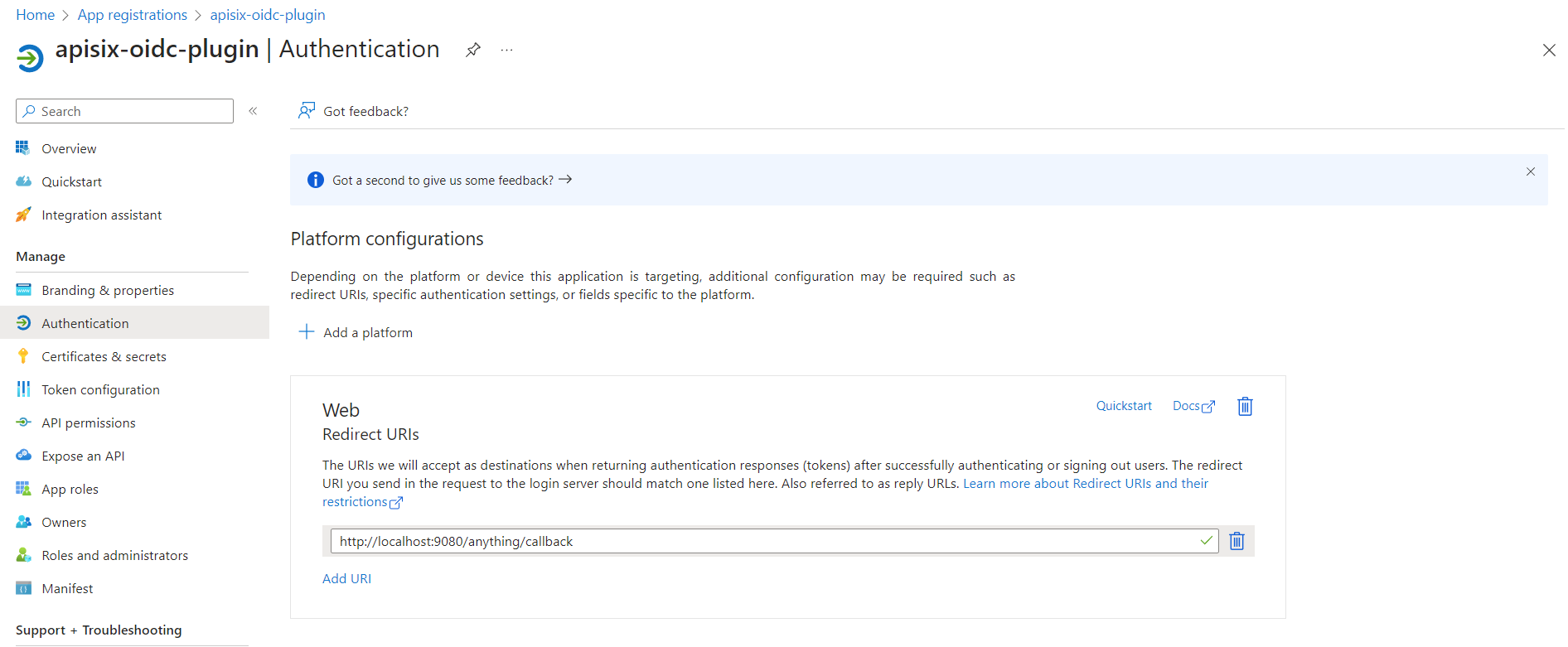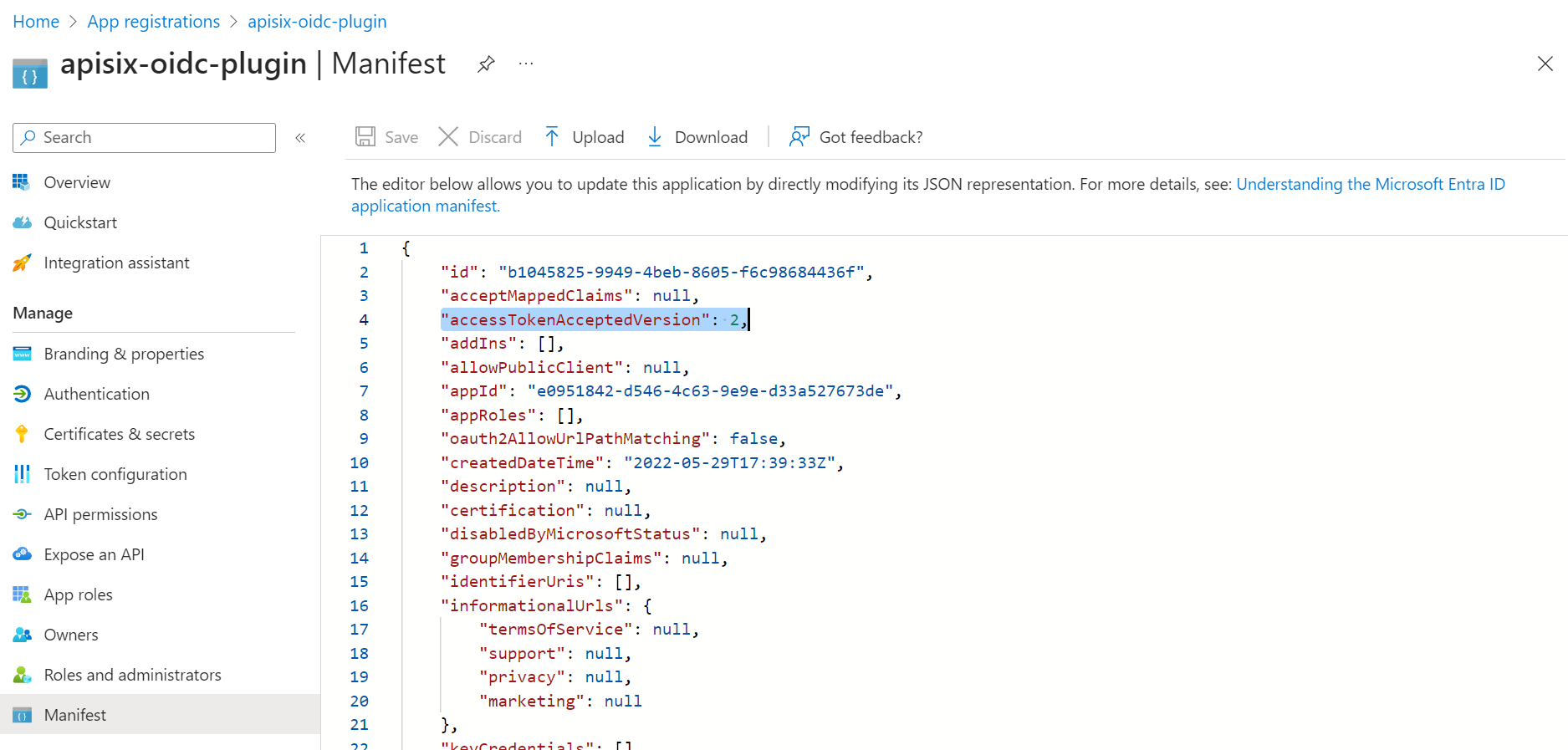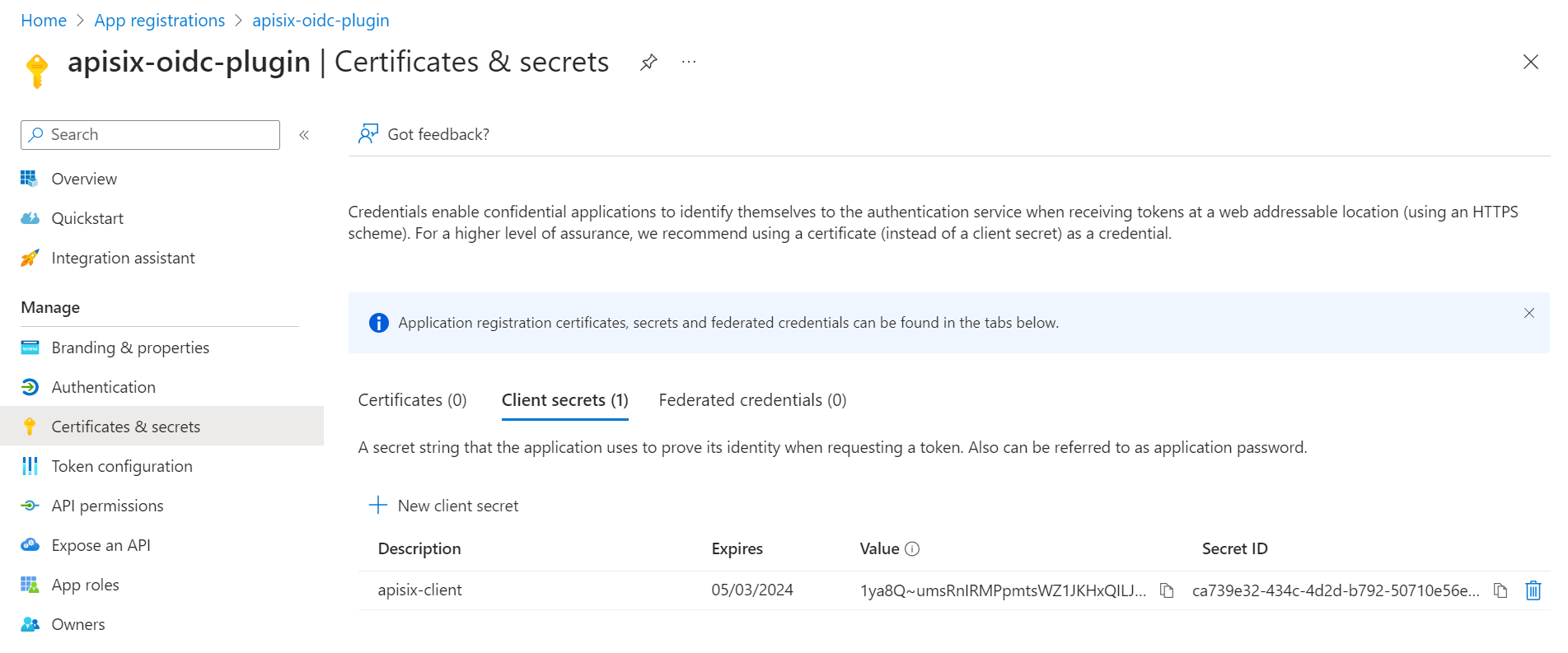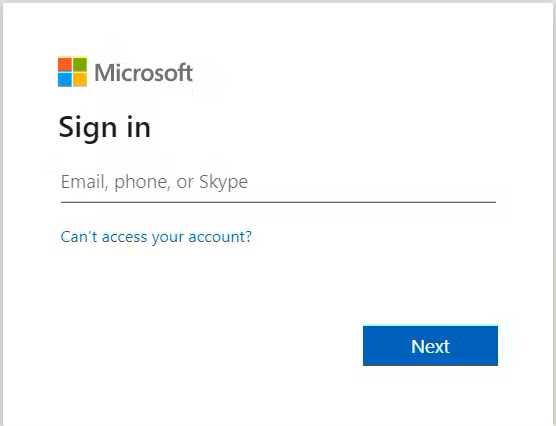Set Up SSO with Microsoft Entra ID (Azure AD)
OpenID Connect (OIDC) is a simple identity layer on top of the OAuth 2.0 protocol. It allows clients to verify the identity of end users based on the authentication performed by the identity provider, as well as to obtain basic profile information about end users in an interoperable and REST-like manner. With APISIX and Microsoft Entra ID (formerly Azure AD), you can implement OIDC-based authentication processes to protect your APIs and enable single sign-on (SSO).
Microsoft Entra ID is Microsoft's cloud-based identity and access management service. It allows organizations to securely manage and authenticate users and devices, ensuring that the right individuals have the appropriate access to company resources. Microsoft Entra ID offers features such as single sign-on (SSO), multi-factor authentication (MFA), and integration with various third-party applications.
The guide will show you how to integrate APISIX with Microsoft Entra ID using authorization code flow and client credentials flow.
Prerequisite(s)
- Install Docker.
- Install cURL to send requests to the services for validation.
- Follow the Getting Started tutorial to start a new APISIX instance in Docker or on Kubernetes.
- Create an Azure account that has an active subscription.
Register an application in Azure
Log in to the Azure portal, go to the App registrations service and register a new application.

Once the app is registered, click on the Authentication tab and click on Add a platform. Choose Web application type and add a new redirect URI http://localhost:9080/anything/callback to the Redirect URIs list under the Web page. This is the address that the application redirects users to upon a successful authentication with Microsoft Entra ID. Click on Configure to save changes.

To configure Microsoft Entra ID to use v2.0 tokens, edit your application Manifest, and set accessTokenAcceptedVersion to 2.

In Certificates & Secrets tab, create a client secret and save the value to a secure location so that you can use it later for APISIX OIDC plugin configuration. You can only view the secret once.

Navigate back to the Overview tab and find Directory (tenant) ID and Application (client) ID. Save them to environment variables along with the client secret:
# replace with your values
export TENANT_ID=dcbd8da3-e0b3-486c-9212-08a199dc3451
export CLIENT_ID=e0951842-d546-4c63-9e9e-d33a527673de
export CLIENT_SECRET=wSY8Q~x4z2Tn6Rq5lA4NTtZ6GLBMGvZF_R2LEcPx
Configure APISIX
In this section, you will create a route with OIDC that forwards client requests to httpbin.org, a public HTTP request and response service.
The route /anything/{anything} of httpbin.org returns anything passed in request data in JSON type, such as methods, arguments, and headers.
Enable OIDC Plugin
Create the route and enable the plugin openid-connect:
- Admin API
- ADC
- Ingress Controller
curl -i "http://127.0.0.1:9180/apisix/admin/routes" -X PUT -d '
{
"id": "auth-with-oidc",
"uri":"/anything/*",
"plugins": {
"openid-connect": {
"client_id": "'"$CLIENT_ID"'",
"client_secret": "'"$CLIENT_SECRET"'",
"discovery": "https://login.microsoftonline.com/'"$TENANT_ID"'/v2.0/.well-known/openid-configuration",
"scope": "openid",
"redirect_uri": "http://localhost:9080/anything/callback",
"bearer_only": false,
"session": {
"secret": "f86cf31663a9c9fa0a28c2cc78badef1"
}
}
},
"upstream":{
"type":"roundrobin",
"nodes":{
"httpbin.org:80":1
}
}
}'
❶ client_id: Microsoft Entra ID client ID.
❷ client_secret: Microsoft Entra ID client secret.
❸ discovery: URI to OIDC discovery document of Microsoft Entra ID.
❹ redirect_uri: URI to redirect to after authentication with Microsoft Entra ID.
❺ bearer_only: Set to false for authorization code flow.
❻ session.secret: Replace with your key used for session encryption and HMAC operation. Required when bearer_only is false.
services:
- name: httpbin Service
routes:
- uris:
- /anything/*
name: auth-with-oidc
plugins:
openid-connect:
client_id: 'e0951842-d546-4c63-9e9e-d33a527673de'
client_secret: 'wSY8Q~x4z2Tn6Rq5lA4NTtZ6GLBMGvZF_R2LEcPx'
discovery: 'https://login.microsoftonline.com/dcbd8da3-e0b3-486c-9212-08a199dc3451/v2.0/.well-known/openid-configuration'
scope: 'openid'
redirect_uri: 'http://localhost:9080/anything/callback'
bearer_only: false
session:
secret: f86cf31663a9c9fa0a28c2cc78badef1
upstream:
type: roundrobin
nodes:
- host: httpbin.org
port: 80
weight: 1
❶ client_id: Microsoft Entra ID client ID.
❷ client_secret: Microsoft Entra ID client secret.
❸ discovery: URI to OIDC discovery document of Microsoft Entra ID.
❹ redirect_uri: URI to redirect to after authentication with Microsoft Entra ID.
❺ bearer_only: Set to false for authorization code flow.
❻ session.secret: Replace with your key used for session encryption and HMAC operation. Required when bearer_only is false.
Synchronize the configuration to APISIX:
adc sync -f adc.yaml
- Gateway API
- APISIX CRD
apiVersion: apisix.apache.org/v1alpha1
kind: PluginConfig
metadata:
namespace: ingress-apisix
name: auth-plugin-config
spec:
plugins:
- name: openid-connect
config:
client_id: e0951842-d546-4c63-9e9e-d33a527673de
client_secret: wSY8Q~x4z2Tn6Rq5lA4NTtZ6GLBMGvZF_R2LEcPx
discovery: https://login.microsoftonline.com/dcbd8da3-e0b3-486c-9212-08a199dc3451/v2.0/.well-known/openid-configuration
scope: openid
redirect_uri: http://localhost:9080/anything/callback
bearer_only: false
session:
secret: f86cf31663a9c9fa0a28c2cc78badef1
---
apiVersion: v1
kind: Service
metadata:
namespace: ingress-apisix
name: httpbin-external-domain
spec:
type: ExternalName
externalName: httpbin.org
---
apiVersion: gateway.networking.k8s.io/v1
kind: HTTPRoute
metadata:
namespace: ingress-apisix
name: auth-with-oidc
spec:
parentRefs:
- name: apisix
rules:
- matches:
- path:
type: PathPrefix
value: /anything/*
filters:
- type: ExtensionRef
extensionRef:
group: apisix.apache.org
kind: PluginConfig
name: auth-plugin-config
backendRefs:
- name: httpbin-external-domain
port: 80
apiVersion: apisix.apache.org/v2
kind: ApisixUpstream
metadata:
namespace: ingress-apisix
name: httpbin-external-domain
spec:
externalNodes:
- type: Domain
name: httpbin.org
---
apiVersion: apisix.apache.org/v2
kind: ApisixRoute
metadata:
namespace: ingress-apisix
name: auth-with-oidc
spec:
ingressClassName: apisix
http:
- name: auth-with-oidc
match:
paths:
- /anything/*
plugins:
- name: openid-connect
enable: true
config:
client_id: e0951842-d546-4c63-9e9e-d33a527673de
client_secret: wSY8Q~x4z2Tn6Rq5lA4NTtZ6GLBMGvZF_R2LEcPx
discovery: https://login.microsoftonline.com/dcbd8da3-e0b3-486c-9212-08a199dc3451/v2.0/.well-known/openid-configuration
scope: openid
redirect_uri: http://localhost:9080/anything/callback
bearer_only: false
session:
secret: f86cf31663a9c9fa0a28c2cc78badef1
upstreams:
- name: httpbin-external-domain
❶ client_id: Microsoft Entra ID client ID.
❷ client_secret: Microsoft Entra ID client secret.
❸ discovery: URI to OIDC discovery document of Microsoft Entra ID.
❹ redirect_uri: URI to redirect to after authentication with Microsoft Entra ID.
❺ bearer_only: Set to false for authorization code flow.
❻ session.secret: Replace with your key used for session encryption and HMAC operation. Required when bearer_only is false.
Apply the configuration to your cluster:
kubectl apply -f oidc-route.yaml
Authenticate with User Credentials
Navigate to http://localhost:9080/anything/test in a browser. You should be redirected to the Microsoft Entra ID sign-in page:

You can customize Microsoft Entra ID sign-in page for your own branding. See how to configure your company branding on the sign-in page.
Sign in with your Azure credentials. You should see a response similar to the following in the browser:
{
"args": {},
"data": "",
"files": {},
"form": {},
"headers": {
"Accept": "text/html,application/xhtml+xml,application/xml;q=0.9,*/*;q=0.8",
"Accept-Encoding": "gzip, deflate",
"Accept-Language": "en-us",
"Cookie": "session=...",
"Host": "localhost",
"Upgrade-Insecure-Requests": "1",
"User-Agent": "Mozilla/5.0 (Macintosh; Intel Mac OS X 10_15_7) AppleWebKit/605.1.15 (KHTML, like Gecko) Version/15.6.1 Safari/605.1.15",
"X-Access-Token": "eyJ...",
"X-Amzn-Trace-Id": "Root=1-65698cfb-262bc17d50bca6de3e855301",
"X-Forwarded-Host": "localhost",
"X-Id-Token": "eyJ...",
"X-Userinfo": "eyJ..."
},
"json": null,
"method": "GET",
"origin": "172.24.0.1, 108.**.**.**",
"url": "http://localhost/anything/test"
}
Authenticate with Client Credentials
The client credentials flow involves a machine-to-machine (M2M) application exchanging credentials with services where there is no user involved.
In this section, you will update the existing route with additional OIDC configurations and authenticate to Microsoft Entra ID with an access token.
Update OIDC Plugin
Update the OIDC plugin on the route to use the JWKS endpoint of the identity server to verify the token:
- Admin API
- ADC
- Ingress Controller
curl -i "http://127.0.0.1:9180/apisix/admin/routes/auth-with-oidc" -X PATCH -d '
{
"plugins": {
"openid-connect": {
"use_jwks": true
}
}
}'
services:
- name: httpbin Service
routes:
- uris:
- /anything/*
name: auth-with-oidc
plugins:
openid-connect:
use_jwks: true
client_id: 'e0951842-d546-4c63-9e9e-d33a527673de'
client_secret: 'wSY8Q~x4z2Tn6Rq5lA4NTtZ6GLBMGvZF_R2LEcPx'
discovery: 'https://login.microsoftonline.com/dcbd8da3-e0b3-486c-9212-08a199dc3451/v2.0/.well-known/openid-configuration'
scope: 'openid'
redirect_uri: 'http://localhost:9080/anything/callback'
bearer_only: false
session:
secret: f86cf31663a9c9fa0a28c2cc78badef1
upstream:
type: roundrobin
nodes:
- host: httpbin.org
port: 80
weight: 1
Synchronize the configuration to APISIX:
adc sync -f adc.yaml
- Gateway API
- APISIX CRD
apiVersion: apisix.apache.org/v1alpha1
kind: PluginConfig
metadata:
namespace: ingress-apisix
name: auth-plugin-config
spec:
plugins:
- name: openid-connect
config:
use_jwks: true
client_id: e0951842-d546-4c63-9e9e-d33a527673de
client_secret: wSY8Q~x4z2Tn6Rq5lA4NTtZ6GLBMGvZF_R2LEcPx
discovery: https://login.microsoftonline.com/dcbd8da3-e0b3-486c-9212-08a199dc3451/v2.0/.well-known/openid-configuration
scope: openid
redirect_uri: http://localhost:9080/anything/callback
bearer_only: false
session:
secret: f86cf31663a9c9fa0a28c2cc78badef1
---
apiVersion: v1
kind: Service
metadata:
namespace: ingress-apisix
name: httpbin-external-domain
spec:
type: ExternalName
externalName: httpbin.org
---
apiVersion: gateway.networking.k8s.io/v1
kind: HTTPRoute
metadata:
namespace: ingress-apisix
name: auth-with-oidc
spec:
parentRefs:
- name: apisix
rules:
- matches:
- path:
type: PathPrefix
value: /anything/*
filters:
- type: ExtensionRef
extensionRef:
group: apisix.apache.org
kind: PluginConfig
name: auth-plugin-config
backendRefs:
- name: httpbin-external-domain
port: 80
apiVersion: apisix.apache.org/v2
kind: ApisixUpstream
metadata:
namespace: ingress-apisix
name: httpbin-external-domain
spec:
externalNodes:
- type: Domain
name: httpbin.org
---
apiVersion: apisix.apache.org/v2
kind: ApisixRoute
metadata:
namespace: ingress-apisix
name: auth-with-oidc
spec:
ingressClassName: apisix
http:
- name: auth-with-oidc
match:
paths:
- /anything/*
plugins:
- name: openid-connect
enable: true
config:
use_jwks: true
client_id: e0951842-d546-4c63-9e9e-d33a527673de
client_secret: wSY8Q~x4z2Tn6Rq5lA4NTtZ6GLBMGvZF_R2LEcPx
discovery: https://login.microsoftonline.com/dcbd8da3-e0b3-486c-9212-08a199dc3451/v2.0/.well-known/openid-configuration
scope: openid
redirect_uri: http://localhost:9080/anything/callback
bearer_only: false
session:
secret: f86cf31663a9c9fa0a28c2cc78badef1
upstreams:
- name: httpbin-external-domain
Apply the configuration to your cluster:
kubectl apply -f oidc-route.yaml
Test Access Token
Obtain an access token for the registered test application in Azure:
curl -i "https://login.microsoftonline.com/$TENANT_ID/oauth2/v2.0/token" -X POST \
-d 'client_id='$CLIENT_ID'' \
-d 'client_secret='$CLIENT_SECRET'' \
-d 'scope='$CLIENT_ID'/.default' \
-d 'grant_type=client_credentials'
The expected response is similar to the following:
{
"token_type": "Bearer",
"expires_in": 3599,
"ext_expires_in": 3599,
"access_token": "eyJ0eXAiOiJKV1QiLCJhbGciOiJSUzI1NiIsImtpZCI6Ii1LSTNROW5OUjdiUm9meG1lWm9YcWJIWkdldyJ9.eyJhdWQiOiJlMDk1MTg0Mi1kNTQ2LTRjNjMtOWU5ZS1kMzNhNTI3NjczZGUiLCJpc3MiOiJodHRwczovL2xvZ2luLm1pY3Jvc29mdG9ubGluZS5jb20vZGNiZDhkYTMtZTBiMy00ODZjLTkyMTItMDhhMTk5ZGMzNDUxL3YyLjAiLCJpYXQiOjE2OTQ2MDczMzAsIm5iZiI6MTY5NDYwNzMzMCwiZXhwIjoxNjk0NjExMjMwLCJhaW8iOiJBU1FBMi84VUFBQUFHZXcvTjhPQm1OSEtaK1cydVNnR0NNckhwRlNERmVuNUNBcTVONG1QQ2ZzPSIsImF6cCI6ImUwOTUxODQyLWQ1NDYtNGM2My05ZTllLWQzM2E1Mjc2NzNkZSIsImF6cGFjciI6IjEiLCJvaWQiOiIxODA5NTNiZi1lZDZlLTRjNjUtYmRiZS01Y2JlNmRhMTI4OTYiLCJyaCI6IjAuQVRvQW80MjkzTFBnYkVpU0VnaWhtZHcwVVVJWWxlQkcxV05NbnA3VE9sSjJjOTdoQUFBLiIsInN1YiI6IjE4MDk1M2JmLWVkNmUtNGM2NS1iZGJlLTVjYmU2ZGExMjg5NiIsInRpZCI6ImRjYmQ4ZGEzLWUwYjMtNDg2Yy05MjEyLTA4YTE5OWRjMzQ1MSIsInV0aSI6IlM5anBfWS1qUjBhcm9lS3NVdnNqQUEiLCJ2ZXIiOiIyLjAifQ.bAt8rh56MK7igDZws0mtSqXDhHvwIyKoxOW7uqSD5aWBaXPxINpNTqIW04n4_p14uLhBlxSufV8WHmS5V1Pdv-QENu9VMUs00blOH38TX0S3WfyCkYuecvWnHc4kYi4TFxTVk1nTvhU7LgOYIHLDb04rRxP-D0tFJ7qo2gI2nSvDChEPCID8WkugPbXJyo1gc49UAuv75d2PhFkidIigDq_DGQQoa88ZLW1iDcQYVgTitEg9zhqSlYksOq1xGClB16sSubnKF6dwqXOfUamAMeu41YLDdgOAb3bS3J54OOe5uUliemHxWo4Z-rfBOI8uOKUioVLv2RImaHylhutaeA"
}
Save the access token to an environment variable:
# replace with your access token
export ACCESS_TOKEN="eyJhbGciOiJSUzI1NiIsInR5cCI6IkpXVCIsImtpZCI6Ikc2elVuYzgtM0JrVlgtZmdnMTdKNSJ9.eyJpc3MiOiJodHRwczovL2Rldi00bGc0aWZzcTRqdnBuN3MyLnVzLmF1dGgwLmNvbS8iLCJzdWIiOiJlQUM4VVRWUEZpcnVmT2g0YTFEWnRjN0YyMHo3eUd1dkBjbGllbnRzIiwiYXVkIjoiaHR0cHM6Ly9jbGllbnRjcmVkZW50aWFscy5jb20iLCJpYXQiOjE2OTMwNDAwMjcsImV4cCI6MTY5MzEyNjQyNywiYXpwIjoiZUFDOFVUVlBGaXJ1Zk9oNGExRFp0YzdGMjB6N3lHdXYiLCJndHkiOiJjbGllbnQtY3JlZGVudGlhbHMifQ.aePOiFlW0q0mlrQwKdtP1MGfY2nX7TSnTrEjoJI03aG7lBCHhPX_WwszhYvtM5c_cyQtcI6R4ibPskpTssdEXGCe2wbOhstPWeIb9rCFf_kA_g0p1wDM8j8egRfl7PLmFffaEmU0eNrgmjTgYQ0Erk63XDykPFOFWiQKPfDQ2hf4jz_3J_VKNqwy7yQuxisnD5TysybGmrONoiBjYLGIymk1ii-qKEoNt5_DRv10aSBwyRtxDZbiwhAKcWNO7zLaJVmZZLg1aTiRYxgIOU-_AP4iAR6Y4vK_GxyHqf7G6j6yH8wqCj8Nm2bLEg8Gqb9Fd-xbpbQCiC3X14ja5NTYtw"
Send a request to the route with the valid access token authorization header:
curl -i "http://127.0.0.1:9080/anything/test" -H "Authorization: Bearer $ACCESS_TOKEN"
An HTTP/1.1 200 OK response verifies that the client application is able to make authorized calls to the API.
Next Steps
APISIX supports more OIDC identity providers, such as Okta, Keycloak, Authgear and Auth0.
In addition, APISIX also supports built-in authentication methods such as key authentication, basic authentication, JWT authentication, and HMAC authentication.